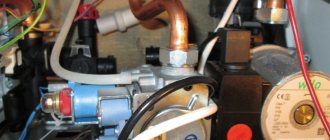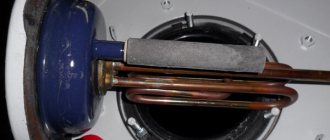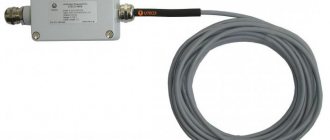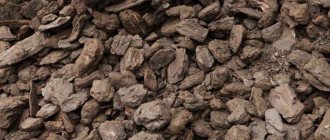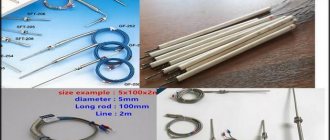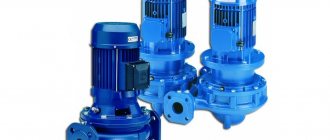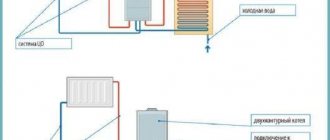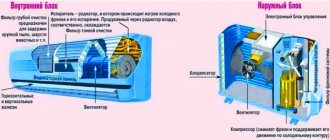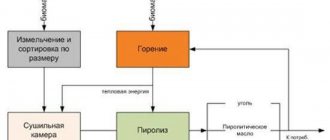Zeotropic and azeotropic mixtures
All refrigerants are divided into two types - single-component and mixtures. Freons consisting of one substance cannot have a temperature glide. Their boiling point is constant and depends only on pressure. They are azeotropic.
The composition of mixtures (multicomponent refrigerants) includes from 2 to 5 (for example, R438a) substances. If components have the same boiling points within a certain range, they are also classified as azeotropic.
Often, a multicomponent refrigerant contains substances with different boiling points. Such mixtures are called zeotropic or non-azeotropic. They have a temperature glide. The dew point (saturation point) plays an important role in them.
Composition of multi-component refrigerant R407F
Properties[ | ]
Physical properties
Freons are colorless gases or odorless liquids. Well soluble in non-polar organic solvents, very poorly soluble in water and other polar solvents. Basic physical properties of methane series freons
| Chemical formula | Name | Technical designation | Melting point, °C | Boiling point, °C | Relative molecular weight |
| CFH3 | fluoromethane | R-41 | -141,8 | -79,64 | 34,033 |
| CF2H2 | difluoromethane | R-32 | -136 | -51,7 | 52,024 |
| CF3H | trifluoromethane | R-23 | -155,15 | -82,2 | 70,014 |
| CF4 | tetrafluoromethane | R-14 | -183,6 | -128,0 | 88,005 |
| CFClH2 | fluorochloromethane | R-31 | — | -9 | 68,478 |
| CF2ClH | chlorodifluoromethane | R-22 | -157,4 | -40,85 | 86,468 |
| CF3Cl | trifluorochloromethane | R-13 | -181 | -81,5 | 104,459 |
| CFCl2H | fluorodichloromethane | R-21 | -127 | 8,7 | 102,923 |
| CF2Cl2 | difluorodichloromethane | R-12 | -155,95 | -29,74 | 120,913 |
| CFCl3 | fluorotrichloromethane | R-11 | -110,45 | 23,65 | 137,368 |
| CF3Br | trifluorobromomethane | R-13B1 | -174,7 | -57,77 | 148,910 |
| CF2Br2 | difluorodibromomethane | R-12B2 | -141 | 24,2 | 209,816 |
| CF2ClBr | difluorochlorobromomethane | R-12B1 | -159,5 | -3,83 | 165,364 |
| CF2BrH | difluorobromomethane | R-22B1 | — | -15,7 | 130,920 |
| CFCl2Br | fluorodichlorobromomethane | R-11B1 | — | 51,9 | 181,819 |
| CF3I | trifluoromethane | R-13I1 | — | -22,5 | 195,911 |
Chemical properties
Freons are relatively inert chemically, so they do not burn in air, are not explosive even when in contact with an open flame, but actively interact with alkali and alkaline earth metals, pure aluminum, magnesium, and magnesium alloys. The formation of mixtures with air or oxygen under pressure and contact with metal heated above 200° C is prohibited! When freons are heated above 250 °C, very toxic products are formed, for example, phosgene COCl2, which was used as a chemical warfare agent during the First World War.
Resistant to acids and alkalis.
What is temperature glide
It is best illustrated using the example of R407c refrigerant. At atmospheric pressure its boiling point is -43.6 °C. With her, he begins to boil. Since it is non-azeotropic, only one component evaporates.
As it evaporates, the composition of the liquid refrigerant changes. Its characteristics change accordingly. The boiling point increases. At one point it stops going into the gaseous phase.
In order for R-407c to continue boiling, it must be heated. In order for it to reach the dew point and boil completely, it must be heated to -36.4 °C. Then the entire refrigerant will turn into a vapor state. The difference between the first and second temperatures is 7.2 degrees Celsius. This is the temperature glide. It is expressed in degrees using the formula:
Tg = Tmax – Tmin
- Tg – Temperature glide;
- Tmax – Dew point at a given pressure;
- Tmin – Boiling point at a given pressure.
What does temperature glide depend on?
Temperature glide is the temperature range in which the refrigerant can be both gas and liquid. This value varies depending on the composition. The fact is that the difference between the boiling points of refrigerants is not constant.
For example, there is some freon that contains gases A and B. They have a slight difference in boiling point. But the properties of refrigerants are different. Therefore, at different pressures the temperature glide will be different.
The higher the pressure, the higher the boiling point of freons. Since their relationship is not direct, the difference between the saturation and boiling temperatures is greater. Accordingly, the temperature glide is greater.
Freon leak in air conditioner
refrigerant cylinders
For an air conditioner, it is normal for freon to leak by 4-7% of the total mass per year. Replenishment of losses on average needs to be carried out every one and a half or two years. If the interblock lines are installed poorly, then the refrigerant escapes in larger quantities through poorly made flaring connections. Then there may be talk about pumping freon into the air conditioner in full or about the emergence of a preliminary need to make up for losses.
If the problem is ignored, the device gradually begins to operate within its capabilities, as a result of which the compressor breaks down, which simply stops being lubricated.
How to Determine a Leak

It is not difficult for a specialist to determine whether there is a freon leak from the air conditioner, but the user himself should also know some signs of loss of the main working substance. You should be wary of:
- noticeable frost or ice appears at the junctions of the refrigeration line and the valves of the outdoor module;
- the quality of cooling is greatly reduced;
- when you turn on the split system, there is a smell of burning;
- Under the taps you can notice oil leaks - this gives an unpleasant odor;
- compressor thermal insulation darkens;
- The device turns off and error codes appear on the display.
If you find any signs of freon leaking from the air conditioner, you should immediately disconnect the device from the power supply and call a technician.
The specialist will connect a nitrogen cylinder through a pressure gauge station, close the ports and release excess pressure into the system. He should immediately wash the pipes and suspected leaks. If a whistle appears and the soap solution bubbles in some place, then there is a hole through which the gas escapes. In this way, the leak of freon from the air conditioner is determined, after which troubleshooting begins.
Instead of a soap solution, you can use a special concentrated liquid, which is pumped into the circuit, and then possible areas of refrigerant loss are illuminated with an ultraviolet lighting device.
Are there any other ways to determine a freon leak from a domestic air conditioner? For one of them you will need a special device - an electronic leak detector, which is equipped with a flexible probe with a sensitive sensor - it allows you to get to the most difficult places. You can also determine the insufficient amount of freon in a start-stop air conditioner using a thermometer, which is brought to the air coming out of the fan. If the indicators do not exceed the established standards of 5-8°C, then gas replenishment is not necessary. If the cause of the losses is leakage of the interblock connections, then the technician will begin soldering the pipes and then refilling the device with the working substance.
What manufacturers write
Due to the fact that the temperature glide depends on pressure, its exact value cannot be specified. Manufacturers of refrigerants measure it differently. For example, they can specify a temperature glide:
- At atmospheric pressure;
- At 0 degrees;
- Medium in pressure range;
- Medium in the boiling range.
Therefore, you should not blindly trust the numbers. The specifications for the same freon may contain different values. Not everyone indicates under what conditions they measured the freon temperature glide. If you come across a new refrigerant, it is better to test it yourself.
History of appearance
After signing the Montreal Protocol in 1987, participating countries began to abandon refrigerants that destroy the Earth's ozone layer. This has led to the development of new refrigerants and systems for their use. The protocol called for the phasing out of halogenated hydrocarbons (haloalkanes).
Freon r410a was developed as a refrigerant with low ozone depletion potential (ODP). This indicator for freon 410a is 0. R410-a gas has a high global warming potential (GPW) of 1800. It traps and retains 1800 times more heat than an equivalent mass of carbon dioxide.
Initially it was planned to use it as an alternative to R-22 freon in new equipment. Since the temperature glide of R-410A freon is less than 0.3 degrees, it was ideal for these purposes. But subsequently more suitable alternatives to freon 22 were developed.
Some manufacturers have patented mixtures under their own brands. The characteristics of 410 freon remain the same regardless of the brand name. It is known by the names:
- SUVA 9100;
- AZ 20;
- Forane 410a;
- Solkane 410.
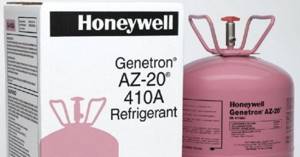
Freon R410a brand Genetron AZ 20, manufactured by Honeywell
Refrigerant temperature glide table
This table contains temperature glide values for zeotropic freons. Data taken from official websites of manufacturers and official documentation. Unfortunately, it is not always indicated how exactly the glide was measured.
| Refrigerant | Glide, °C |
| R401B | 5 |
| R404A | 0,5 |
| R407A | 4,5 |
| R407C | 7,1 |
| R407D | 6,5 |
| R408A | less than 0.6 |
| R410A | less than 0.3 |
| R414B | 7 |
| R417A | 4,7 |
| R422A | 2,5 |
| R422B | 2,7 |
| R422D | 4,5 |
| R424A | 3 |
| R426A | less than 1 |
| R427A | 7 |
| R428A | 0,8 |
| R434A | 1,5 |
| R438A | 4 |
| R442A | 4,6 |
| R448A | 4,5 |
| R449A | 4,5 |
| R450A | 0,4 |
| R513A | 0,8 |
In this article, we tried to popularly explain what the temperature glide of refrigerants is and what it depends on. The average glide of the most popular multi-component freons was also given. Don't forget to share it with your colleagues and friends !
Latest publications
- Which freezer is better, No Frost or regular?
- Top 10 air conditioners for apartments 2020-2021
- 30+ reasons: Why the refrigerator makes strange sounds, how to fix the problem
- 6 brands and 6 models: Which refrigerator to buy, inexpensive but good, with No Frost
- 20+ reasons: Why the refrigerator works but does not freeze, what is the problem, how to fix it
- Atlant, Biryusa, Indesit - which refrigerator is better and why
- Is it possible to place a refrigerator next to the stove? How to protect your refrigerator?
- TOP 10 best manufacturers and brands of refrigerators today
- Freon R407c - characteristics, features of use and replacement
- 13 reasons why the refrigerator constantly works and does not turn off
Application, use
Freon R134a is a one-component gas. If there is a leak, it does not require a complete refill. Equipment operating on this refrigerant can be refilled without loss of operating efficiency. This is a big advantage compared to air conditioning and refrigeration systems based on R410a, R407c, R404. Freon R134a is also used as a component of all effective substitutes for freon R22.
R134a refrigerant is non-toxic; it is used in the production of inhalers, aerosols, and capsules for freezing injuries. By following basic safety and use rules, negative effects on human health can be avoided.
The molar mass of tetrafluoroethane is 102.03 g/mol, air – 29 g/mol. When there is a leak, the gas falls down and accumulates at floor level, in the basement. This property of HFC-134a prevents it from entering the lungs under normal conditions.
Freon 134 is not compatible with mineral oils. When they come into contact, foaming may occur, oil may enter the system, and deposit on its walls. This leads to the formation of narrowed areas and blockages. Equipment using this refrigerant must be filled with PAG or POE synthetic oil.

